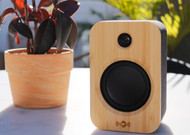How to Break in Speakers and Why You Should
Posted by House of Marley on May 21st 2024
Did you know you’re supposed to break in your speakers? Like a new pair of shoes or a king-sized mattress, speakers are better after some use.
Luckily, you don’t have to run a marathon or suffer through sleepless nights to make the most of your new purchase. Today, we’re walking you through how to break in speakers for the best possible listening experience.
What is Speaker Break-In?
As you might have guessed, speaker break-in is the act of gradually wearing in new speakers. Think of it as letting your speakers “warm up.”
Practically speaking, breaking in your speakers means playing music on them until they sound the way the manufacturer intended.
Why Speaker Break-In Necessary
When most speakers arrive from the factory, the components are stiff and unused. Aside from some workbench QA testing, they’ve never seen any action.
Speaker break-in gets the inner workings moving and grooving, allowing them to reach their intended state. Once the rigidity wears off, the speakers will be more flexible and dynamic—and better at reproducing the sounds of your favorite albums.
Believe it or not, break-in applies to almost anything with a speaker. Even small portable speakers and headphones may need to be broken in to sound their best.
How to Properly Break in Speakers
As mentioned, breaking in your speakers is as easy as using them. All you have to do is play some music, and your new speakers will eventually reach peak performance.
However, there’s more to it than putting on an album. If you want to break in your speakers properly, here’s what you need to do.
Initial Setup
Before you can break in your new speakers, you’ll have to set them up (along with your amplifier and record player, if applicable).
Once you’ve taken your speakers out of the box, we recommend that you:
- Power them up – For corded speakers, find the closest wall plug; for battery-powered wireless options, insert the appropriate batteries.
- Position them away from the wall – Ideally, your speakers should be two to three feet from the wall. Any closer, and you might hear reflections that muddy the sound quality.[1]
- Optimize your listening experience – Assuming you bought a pair of home or bookshelf speakers, you’ll want to find the best listening position. Form a triangle between yourself and the two speakers to create an optimal stereo image, placing them roughly at head height.
Choosing the Right Audio
Playing any music will break in your speakers, but if you want to improve the process, play songs with wide dynamic ranges. We’re talking lots of bass, punchy mids, and sparkling high-end. The more sonic variation there is, the more of a “full-body workout” your speakers will receive.
The easiest way to run the frequency gamut? Listen to varied music genres. Fire up a playlist that includes:
- Reggae
- Rock
- Hip hop
- Classical
- Pop
That way, you can guarantee you hit all the right notes—literally. Plus, you might even discover your next musical obsession!
Volume and Duration Considerations
When you’re first breaking in your speakers, start at a low volume level. The speaker components will need time to wake up from their lengthy in-the-box slumber.
Once you’ve spent a few hours at lower listening levels, you can gradually increase the volume, eventually cranking the speakers to full.
How long is long enough for a break-in? Some say it can take as much as 100 hours to truly break in speakers, but 20–30 hours is plenty. And since regular listening will still break in your speakers, you don’t have to wait that long. Just know it’ll take some time for them to reach their maximum potential—and that’s okay.
How to Tell Your Speakers Have Been Broken In
Whether you’re working with Bluetooth speakers or a new subwoofer, you’ll know you’ve reached the broken-in point when… well, it’s not always easy to tell.
Sound quality is notoriously hard to write about. However, you’ll hear terms like “warmth” or “roundness” applied to well-broken-in speakers. The harshness of the highs mellows out a little, and the lows throb a little more.
But breaking in a speaker is like finding true love: When you know, you know. One day, you’ll be listening to your favorite tune, and it’ll suddenly sound like you’re hearing it for the first time again.

Quality Speakers Just Waiting to Be Broken In
At the end of the day, breaking in speakers isn’t an absolute must. If you accept that your speakers won’t sound their best from the moment you plug them in, you can play music as normal. After some regular usage, your speakers will reach their full potential.
When you have top-notch speakers that are begging to be played, it is hard to wait for that breaking-in period to be over. At House of Marley, we make high-quality speakers that you’ll want to crank up and enjoy from the moment you unbox them. Learn more on how to choose a Bluetooth speaker in our blog.
That said, breaking them in is worth the wait. Take a little time, be patient, and you’ll have well-crafted, incredible-sounding speakers for years to come.
Sources:
Lifewire. How to Place Stereo Speakers for the Best Performance. https://www.lifewire.com/placing-speakers-correctly-3134857













